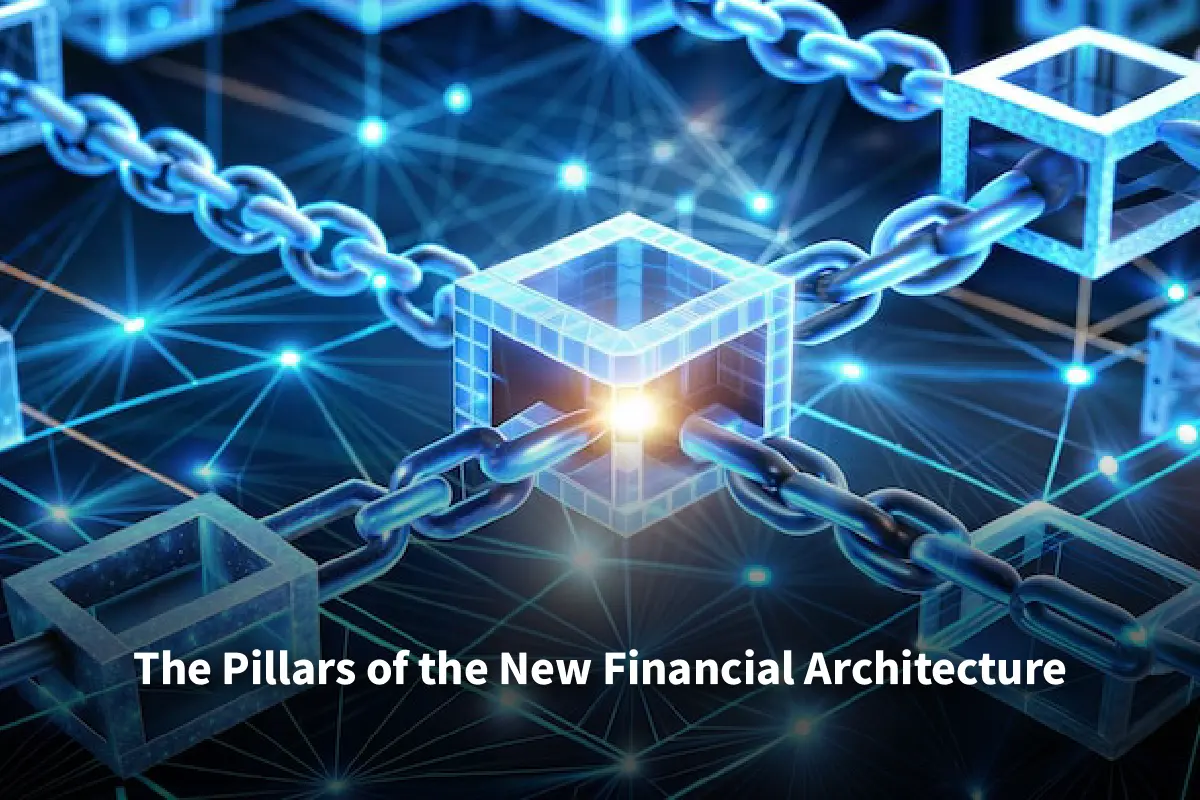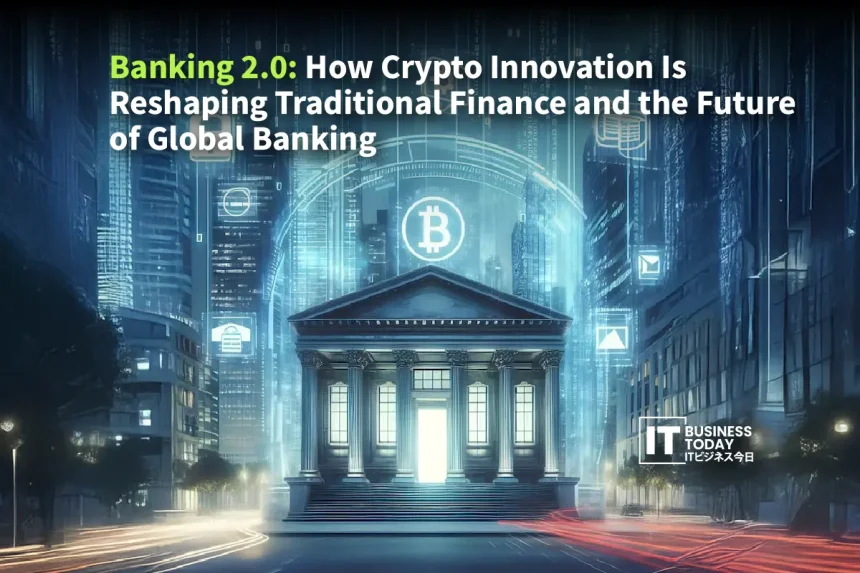For years, global finance has been like a strong fortress. Its walls depend on outdated systems, central control, and intermediaries. They have mostly gone unchallenged. Only fringe thinkers suggested a major redesign. Today, that fortress is not under siege; it is being rewired from the inside out. The catalyst isn’t a hostile takeover. It’s a quiet, steady tech revolution. This change comes from cryptocurrency and its base, blockchain. This isn’t about replacing banks with chaos. It’s about the rise of Banking 2.0. This new system will be hybrid, efficient, and much more accessible for all.
Business leaders are no longer just for or against Bitcoin. The main focus now is on decentralized finance, tokenization, and smart contracts. These engines drive the transformation. Understanding their path is now a key strategy, not just a technical task.
The Pillars of the New Financial Architecture

Banking 2.0 uses new ideas that change and improve traditional financial services. At its core is blockchain. It’s a digital ledger that can’t be changed. Plus, it’s shared across many locations. Think of a financial record stored not in one bank, but shared across a network of computers. Each transaction gets cryptographically sealed in a block. Then, it links to the previous block. This builds a clear and permanent history. Trusting protocols instead of institutions is key to today’s change.
Also Read: Hyperautomation in Factories: How Japan Is Building Lights-Out Manufacturing Systems
Building upon this foundation are smart contracts. These aren’t legal documents. Instead, they are self-executing lines of code. They automate the terms of an agreement. A simple analogy is a digital vending machine. You do not need to trust the machine’s owner; you trust its programmed logic. Insert the right cryptocurrency, and the snack will be released automatically. Now, apply this to a complex syndicated loan or a trade finance agreement. The contract releases funds automatically when it gets verified shipping documents. This cuts out days of manual work and lowers counterparty risk to almost zero. This is not just a small improvement; it completely reworks how contracts are fulfilled.
The biggest change from these technologies is Decentralized Finance, or DeFi. DeFi protocols copy traditional finance services. These include lending, borrowing, insurance, and trading. They use open blockchain networks. This means they operate without banks or brokers. Users deposit assets in liquidity pools. Others can then borrow from these pools. Algorithms determine interest rates based on supply and demand. This builds a system that everyone can access. It runs all the time and is much clearer than regular markets. The DeFi space is still growing. As of 2025, the total value locked across DeFi protocols is about US$ 150 billion, with Ethereum alone accounting for nearly US$ 88.5 billion. Between 2018 and 2022, DeFi protocols lost at least US$ 3.24 billion to hacks and exploits. It also faces regulatory challenges. Its key innovation is removing middlemen from financial services. This shift is transforming the whole industry.
From Disruption to Collaboration
Traditional finance used to dismiss the idea, but now it has changed for good. The chance for better efficiency, lower costs, and new revenue is too big to miss. We’re in an era of institutional adoption. The banks that once scoffed are now building.
A clear example is cross-border payments. The traditional correspondent banking model has many intermediaries. Each one takes a fee and adds time. A transaction can take days to settle. Blockchain networks can finish transfers in seconds. They also do this at a much lower cost. Major financial institutions aren’t just observing. They are building their own digital asset platforms for wholesale payments. They see that the old model is no longer competitive.
Tokenizing real-world assets could build a market worth trillions. Tokenization makes rights an asset, similar to real estate, a famous painting, or a corporate bond. It creates a digital token on a blockchain. This opens up strong liquidity for assets that are usually hard to trade. Imagine a commercial real estate property. Instead of one person owning it, it can be split into thousands of tokens. This lets smaller investors join in and trade shares easily with just a click. This opens up investment options for everyone. It also creates new types of assets. BlackRock’s move into tokenized assets proves this is not just a speculative future. It’s a reality that’s coming soon.
Central banks are exploring Central Bank Digital Currencies, or CBDCs. These aren’t like the volatile, decentralized cryptocurrencies. They are digital versions of government-backed currency. A digital dollar or euro on a controlled blockchain could make monetary policy simpler. It might also boost financial inclusion for the unbanked. Plus, it would offer a stronger payments system. The global push is unmistakable: 137 countries and currency unions, representing nearly 98% of world GDP, are now exploring CBDCs, with 49 pilot projects underway and 3 countries, the Bahamas, Jamaica, and Nigeria, having fully launched retail versions. In India, for example, the digital rupee in circulation grew by 334% year-on-year, reaching ₹10.16 billion (US$ 122 million) by March 2025. The global push for CBDCs shows that this tech aims to boost national financial systems, not weaken them.
Risks and the Road Ahead
Viewing this transition with rose-tinted glasses would be a big mistake. The path to Banking 2.0 is fraught with complexity. Regulatory uncertainty remains the single greatest hurdle. How can old securities laws apply to a decentralized autonomous organization? How can you ensure compliance with anti-money laundering rules in a pseudonymous system? Governments and regulators around the world are working to build frameworks. They shield consumers and help maintain stability. They also want to avoid stifling innovation. The new rules will determine how quickly and in what way this change occurs.
Technical and security challenges persist. The blockchain is very secure. Apps built on it, like exchanges and digital wallets, attract skilled hackers. The industry needs to grow. It should emphasize strong cybersecurity and effective insurance models. This will help build trust for widespread adoption. Also, some networks still need to scale up. We need to speed up transactions and lower costs to improve global finance. Surveys by the Bank for International Settlements show that around 60% of central banks are running experiments or pilots, up from just 42% in 2019. A CFA Institute report shows 69% of developed-market central banks cite cybersecurity risks as their primary worry, followed closely by privacy concerns.
The biggest challenge is likely cultural and operational. Integrating blockchain technology means financial institutions must adjust how they operate. It needs new talent and fresh risk management frameworks. It also needs a readiness to rethink old processes. Winners in the Banking 2.0 era won’t just add new technology. They will change their whole organization to be agile, tech-savvy, and cooperative.
The Strategic Imperative for Business Leaders

Today’s business leaders should think about when and how this transition will affect their industry, not if it will. The effects reach well beyond the finance team. Tracking goods clearly and steadily can transform supply chain management. Smart contracts can automatically handle payments for intellectual property and royalties. Corporate treasury functions will gain new tools. These tools manage assets and handle transactions.
The call to action isn’t to rush into tokenizing your company. Instead, focus on really understanding these technologies. Begin with education. Encourage your strategy and innovation teams to explore pilot projects. Focus on use cases that matter to your business. Engage with the regulatory conversation. The rules are being written now, and industry input is critical. Most importantly, keep an open mind. Try new things and experiment. The key feature of Banking 2.0 is interoperability. This means old and new systems work together smoothly.
The future of global banking won’t be a sudden change. Instead, it will be a smart mix of strategies. Traditional institutions will blend with the fast efficiency of decentralized protocols. The result will be a financial system that is inclusive and clear. It will help boost the global economy in the 21st century. The fortress walls aren’t crumbling. They’re getting new digital gateways. The leaders who hold the keys will be those who had the foresight to help build them.







